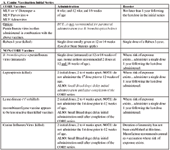Vaccines and vaccination: Issues and controversies (Part 1) (Proceedings)
Over the last decade, publication of vaccination guidelines for the dog and cat have represented an effort on behalf of scientists, academicians, industry, and practicing veterinarians to develop recommendations based on the most current scientific studies available.
Over the last decade, publication of vaccination guidelines for the dog and cat have represented an effort on behalf of scientists, academicians, industry, and practicing veterinarians to develop recommendations based on the most current scientific studies available. Although the guidelines were originally written for veterinarians practicing in North America, it has become apparent they are being read and used by veterinarians in several countries. In 2007, the World Small Animal Veterinary Association (WSAVA) first published canine and feline vaccine guidelines for countries outside of North America. WSAVA Vaccination Guidelines have recently been updated (2010). All published recommendations can be accessed on-line at no cost.1
For veterinarians who practice in the US, the decision to implement either the AAHA or AAFP Vaccine Guidelines is optional...the Guidelines are merely recommendations. Furthermore, the Vaccine Guidelines are not a universal protocol applicable to all dogs and all cats. Instead, they are intended to guide decisions leading to the development of a rational vaccination protocol. Today, however, the AAHA and AAFP Vaccination Guidelines do appear to represent an emerging Standard of Care for the profession.
This 2-part presentation centers on both ISSUES and CONTROVERSIES surrounding the selection and use of vaccines for companion animals. PART I (ISSUES) provides insight on vaccination protocols representative of those used by veterinarians (US) who follow the AAHA and AAFP Vaccination Guidelines. PART II (CONTROVERSIES) is FAQ-based and addresses the most commonly asked, and debated, questions regarding vaccine use and administration. The FAQs (Part II) are subdivided into 4 sections: Vaccine Selection; Vaccine Administration; Core Vaccines; Non-Core Vaccines.
While much of the information included is derived from the 2010 AAHA Canine Vaccine Guidelines (scheduled for publication in Sept 2010), the 2006 AAFP Feline Vaccine Guidelines, and the 2010 Report of the WSAVA Vaccine Guidelines Group (VGG), some information included below addresses questions has not specifically been addressed in published Guidelines.
The following tables illustrate representative vaccination protocols (dog & cat) that are currently in use by veterinarians who follow the recommendations outlined in the AAHA and AAFP Vaccination Guidelines. NOTE: these protocols are not intended to define or otherwise recommend a specific protocol; these are simply suggested formats that may be referred to when reviewing or re-developing protocols.
A. Canine Vaccination-Initial Series

A. Canine Vaccination-Initial Series
B. Canine Vaccination-Adult
• CORE vaccines (distemper+parvovirus+adenovirus-2 and rabies)...single dose every 3 years.
• Non-CORE vaccines: administer annually where risk of exposure exists.
C. Feline Vaccination-Initial Series:
D. Feline Vaccination-Adult:

C. Feline Vaccination-Initial Series: • CORE Vaccines (MLV panleukopenia+herpesvirus+calicivirus): single dose every 3 years.
• Recombinant (NON-adjuvanted) Rabies: single dose annually [optional: Killed virus rabies vaccine-NOTE: all feline killed vaccines are adjuvanted].
• Non-CORE Vaccines: (FeLV) recommended annually ONLY if risk is sustained (ie, outdoor cats). The recombinant FeLV vaccine (administered transdermally) is not adjuvanted; all other FeLV vaccines contain adjuvant.
1 America Animal Hospital Association's Canine Vaccine Guidelines-2010): Publication is expected in September 2010; the full text will be available at www.aahanet.org
American Association of Feline Practitioners Feline Vaccine Guidelines-2006: available at www.catvets.com
World Small Animal Veterinary Association's Vaccine Guidelines-2010: available at www.wsava.org